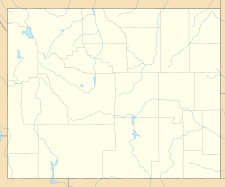Lower Fremont Glacier facts for kids
Quick facts for kids Lower Fremont Glacier |
|
|---|---|
| Type | Mountain glacier |
| Coordinates | 43°07′56″N 109°35′49″W / 43.13222°N 109.59694°W |
| Length | .50 mi (0.80 km) |
| Terminus | Moraines/proglacial lake |
| Status | Retreating |
The Lower Fremont Glacier is a large ice mass found in the Wind River Range in Wyoming, USA. It is located on the eastern side of the Continental Divide. This glacier is part of the Fitzpatrick Wilderness area within the Shoshone National Forest. It is one of many glaciers in the Rocky Mountains of America.
The Lower Fremont Glacier flows towards the southeast. Over time, this glacier has been shrinking. As it melts and moves back, it leaves behind piles of rock and dirt called moraines. It also creates a lake in front of it, known as a proglacial lake. The Lower Fremont Glacier is separated from another glacier, the Bull Lake Glacier, by a moraine. It is also separated from the Upper Fremont Glacier by tall cliffs.
Contents
What is a Glacier?
A glacier is a huge body of ice that moves slowly over land. Think of it like a very slow-moving river made of ice! Glaciers form in places where snow falls but does not completely melt during the summer. Over many years, layers of snow build up and get pressed together. This pressure turns the snow into dense ice.
How Glaciers Move
Glaciers move because of gravity. The weight of the ice makes it slowly slide downhill. They can also flow like a very thick liquid. This movement can carve out valleys and shape mountains over thousands of years.
Location of Lower Fremont Glacier
The Lower Fremont Glacier is in a special part of Wyoming. It is located in the northern section of the Wind River Range. This mountain range is part of the larger Rocky Mountains system that stretches across North America.
The Continental Divide
The glacier sits on the east side of the Continental Divide of the Americas. The Continental Divide is like an imaginary line that runs through the Americas. It separates the river systems that flow to the Atlantic Ocean from those that flow to the Pacific Ocean. Water on the east side of the divide flows towards the Atlantic, while water on the west side flows towards the Pacific.
Protected Wilderness
The Lower Fremont Glacier is inside the Fitzpatrick Wilderness. This is a protected area where human activity is limited to preserve nature. It is also part of the Shoshone National Forest. National forests are managed for many uses, including recreation and wildlife protection. Being in a wilderness area means the glacier is in a very natural and untouched environment.
Features of Lower Fremont Glacier
The Lower Fremont Glacier is about .50 mi (0.80 km) long. This makes it one of the larger glaciers in the region. Its movement and melting create unique landforms around it.
Moraines
As the glacier moves, it acts like a giant bulldozer. It pushes and carries rocks, soil, and other debris. When the glacier melts and retreats, it leaves these materials behind. These piles of rock and dirt are called moraines. The Lower Fremont Glacier has left behind "lateral moraines," which are ridges of debris along its sides.
Proglacial Lakes
When a glacier melts, the water often collects in front of it. This forms a lake called a proglacial lake. The rapid melting of the Lower Fremont Glacier has created one of these lakes at its front. These lakes are often very cold and can contain sediment from the glacier.
Glacier Retreat
The Lower Fremont Glacier is currently "retreating." This means it is shrinking and getting smaller. Glaciers retreat when more ice melts away each year than is added by new snowfall.
Why Glaciers Retreat
Glacier retreat is often linked to changes in climate. When temperatures get warmer, glaciers tend to melt faster. This can affect water supplies for people and wildlife, as glaciers store a lot of fresh water. Scientists study glaciers like the Lower Fremont Glacier to understand more about Earth's climate and how it is changing.


